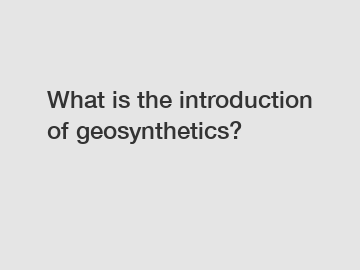What is the introduction of geosynthetics?
Geosynthetics are man-made materials that are used to perform certain functions in geotechnical engineering and civil construction projects. These materials are primarily used to enhance the properties of soils and other materials in order to improve the overall performance of the construction project. Geosynthetics offer a wide range of benefits in terms of strength, durability, and cost-effectiveness, making them a popular choice in various applications such as roads, landfills, dams, and erosion control measures.
Types of Geosynthetics:
Geotextiles:

Geotextiles are the most common type of geosynthetics. They are permeable fabrics made from synthetic fibers and are commonly used to separate, filter, reinforce, and protect soils. Geotextiles provide stability to the soil, prevent erosion, and improve drainage in various construction projects. They are widely used in applications such as road construction, embankments, retaining walls, and coastal protection.
Geomembranes:
Geomembranes are impermeable sheets or liners made from synthetic materials such as HDPE, PVC, or EPDM. These sheets are used to control the flow of fluids and prevent leakage in various applications such as landfill liners, pond liners, and irrigation canals. Geomembranes are highly resistant to chemicals, UV rays, and punctures, making them an effective solution for containment purposes.
Geogrids:
Geogrids are high-strength polymer grids used to enhance the stability of soils by providing reinforcement. They are commonly used in slope stability, retaining walls, and pavement reinforcement applications. Geogrids can effectively distribute loads and reduce deformation, providing long-term stability to the structure. They are commonly made from materials such as polypropylene or polyester and are available in different strengths and configurations.
Geocomposites:
Geocomposites are a combination of two or more geosynthetic materials, specifically designed to perform multiple functions. They are often used to improve drainage, filtration, separation, and reinforcement properties in geotechnical applications. Geocomposites can consist of different combinations, such as geotextile-geomembrane composites, geotextile-geogrid composites, or geotextile-drainage composites. These materials offer the advantage of combining the beneficial properties of various geosynthetics in a single product.
Benefits of Geosynthetics:
- Enhanced soil stability and reinforcement: Geosynthetics improve the strength and stability of soils, enabling the construction of structures in challenging terrains.
- Cost-effectiveness: Geosynthetics offer a cost-effective solution compared to traditional construction methods, reducing the overall project cost.
- Environmental sustainability: Geosynthetics help in preventing soil erosion, improving water quality, and reducing the need for excavation and disposal of natural resources.
- Durability and longevity: Geosynthetics are designed to withstand harsh environmental conditions, providing long-term performance and durability.
- Versatility: Geosynthetics can be used in a wide range of applications and can be customized to meet specific project requirements.
Conclusion:
Geosynthetics have revolutionized the field of geotechnical engineering and civil construction by providing a range of innovative solutions for soil stabilization, reinforcement, filtration, and drainage. With their numerous benefits, geosynthetics have become an integral part of modern construction practices. Their versatility, cost-effectiveness, and durability make them an ideal choice for various applications. By incorporating geosynthetics into infrastructure projects, engineers and construction professionals can ensure improved performance, reduced maintenance, and increased sustainability.
Contact Us:
If you have any further questions or require assistance with geosynthetics for your construction projects, please contact us at [insert contact information]. Our team of experts will be happy to help you with your queries and provide the necessary guidance to ensure success in your projects.
If you want to learn more, please visit our website trp geomembranes supplier, trp geomembranes company, geotube exporter.

Comments